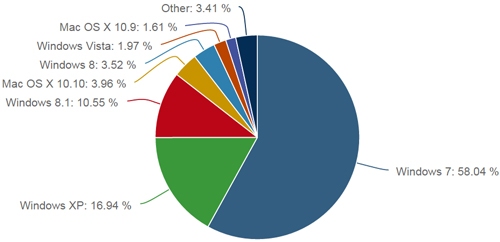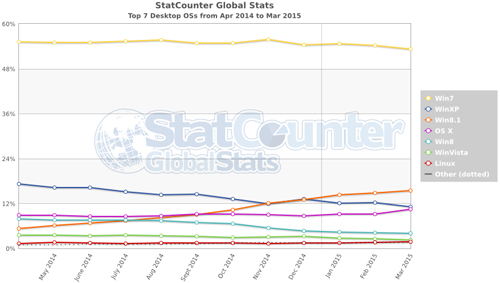A Year After Support Cutoff, Windows XP May Still Have 250 Million Users
A year to the day that Microsoft pulled the plug on Windows XP support, the operating system remains heavily used worldwide. How heavily used? A little back-of-the-envelope math puts the number at up to 250 million users.
Extended support ended for Windows XP on April 8, 2014. That meant no more security updates or technical support for the operating system, which at that time was already 12 years old.
The two major share tracking outfits, Net Applications and StatCounter, both report significant ongoing use of Windows XP in their latest public data covering March 2015.
According to Net Applications, Windows XP users account for nearly 17 percent of worldwide share.
 Net Applications' worldwide share figures by operating system for March 2015. A year after end-of-support, only Windows 7 has more share than Windows XP.
Net Applications' worldwide share figures by operating system for March 2015. A year after end-of-support, only Windows 7 has more share than Windows XP.
StatCounter puts Windows XP share at just over 11 percent. XP's share in the United States is lower, 6.5 percent, according to StatCounter.
 [Click on image for larger view.]
StatCounter's worldwide desktop operating system data shows Windows XP trailed only Windows 8.1 and Windows 7 by the end of March 2015.
[Click on image for larger view.]
StatCounter's worldwide desktop operating system data shows Windows XP trailed only Windows 8.1 and Windows 7 by the end of March 2015.
Applying those percentages to Microsoft's frequently stated claim of 1.5 billion Windows users worldwide gives a ballpark estimate of how many Windows XP users are still out there. The range goes from 167 million using the StatCounter figure to 254 million using the Net Applications figure.
"There's actually still a lot of people running Windows XP," said Kasper Lindgaard, director of research and security at Secunia, in a recent telephone interview about Secunia's Annual Vulnerability Review.
Before the deadline, much concern was focused on how vulnerable all those Windows XP machines would be to newly discovered flaws. Since the support deadline, there's been less attention paid to the issue, other than a Microsoft decision to patch a particularly serious flaw affecting Windows XP a few weeks after the support deadline (MS14-021).
 The warning that has greeted visitors to Microsoft's Windows XP end-of-support page since April 8, 2014.
The warning that has greeted visitors to Microsoft's Windows XP end-of-support page since April 8, 2014.
Nonetheless, other new vulnerabilities discovered since April 8, 2014 probably affected Windows XP, as well, Lindgaard said.
"Vulnerabilities that affect Windows 8 only or Windows 7 only probably won't affect Windows XP," Lindgaard said. "It's fair to assume that some vulnerabilities that affect older versions of the Windows client and Windows server may also affect Windows XP."
Meanwhile, as the anniversary of the Windows XP support cutoff passes, other deadlines approach. On July 14 of this year, support ends for Windows Server 2003. On the same day, Microsoft plans to end anti-malware signature updates for Windows XP on Microsoft Security Essentials. A little further out, support ends for SQL Server 2005 on April 12, 2016.
Posted by Scott Bekker on April 08, 2015